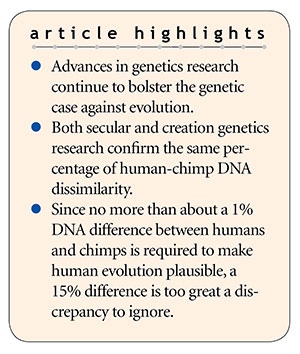 The improvement of DNA sequencing technology, along with scientific advances in the field of genomics, is proving to be a profound enemy of evolution. Two new discoveries that challenge the human evolution paradigm were reported nearly simultaneously—one by a secular scientist and the other by myself. Remarkably, the corroborating data produced in both reports are in perfect agreement.
The improvement of DNA sequencing technology, along with scientific advances in the field of genomics, is proving to be a profound enemy of evolution. Two new discoveries that challenge the human evolution paradigm were reported nearly simultaneously—one by a secular scientist and the other by myself. Remarkably, the corroborating data produced in both reports are in perfect agreement.
The improvement of DNA sequencing technology, along with scientific advances in the field of genomics, is proving to be a profound enemy of evolution. ![]()
A key element of the evolutionary paradigm is the idea that human DNA and chimpanzee DNA are 98.5% identical. This level of DNA similarity is needed to undergird the hypothesis that humans and chimps shared a common ancestor three to six million years ago. Based on known mutation rates in both humans and chimps, anything significantly less than a 98.5% DNA similarity would destroy the foundation of the entire theory.
When I began studying the scientific literature on the subject, I realized there were serious problems with the evolutionary idea of nearly identical human and chimp DNA. In every publication I evaluated, it became clear researchers had cherry-picked highly similar DNA sequences that supported evolution and discarded the data that were dissimilar.1 I recalculated DNA similarities from these studies by factoring back in omitted data and obtained drastically lower levels of human-chimp DNA similarity—between 66% and 86%.
Another major issue I uncovered is that the chimpanzee genome was literally put together to resemble the human genome.2 This little-known fact was accomplished by taking the small snippets of DNA produced after sequencing and lining them up on the human genome. The human genome guided the researchers throughout the chimp genome assemblage process.
Despite these issues, brought about because of scientists’ evolutionary bias, continuing improvement in DNA sequencing technology is slowly bringing the truth to light. The newest version of the chimpanzee genome was recently completed, and the results not only validate my past research but also spectacularly confirm new research I have just published.3
The research paper for the new chimp genome completely sidesteps the issue of DNA similarity with humans.4 Nevertheless, University of London evolutionist Richard Buggs analyzed the results of a comprehensive comparison of the new chimp genome with the human one and posted his shocking anti-evolutionary findings. He stated, “The percentage of nucleotides in the human genome that had one-to-one exact matches in the chimpanzee genome was 84.38%.”5
What makes Dr. Buggs’ analysis more amazing is the fact that my own recently published research using a different algorithm gave the same results. In my study, I aligned 18,000 random pieces of high-quality chimp DNA about 31,000 DNA letters long (on average) onto human and several different versions of the chimp genome. Not only did my data show that the older version of the chimp genome (PanTro4) that had been used to support evolution was deeply flawed and humanized, but they also showed the aligned segments of chimp DNA were on average only 84.4% identical to human—the same level reported by Buggs.
These new results by both myself and Buggs also closely match a 2016 study I published that indicated the overall human-chimp DNA similarity was likely no more than 85%.6 Based on the most recent research, the difference between the human and chimp genomes is estimated to be about 15%.
Once again, the scientific accuracy of the Bible is vindicated regarding the uniqueness of humans. ![]()
A 15% DNA difference between humans and chimps is a discrepancy that can’t be ignored when no more than about a 1% difference is required to make human evolution seem at all plausible. Once again, the scientific accuracy of the Bible is vindicated regarding the uniqueness of humans as stated in Genesis 1:27: “So God created man in His own image; in the image of God He created him; male and female He created them.”
References
- Tomkins, J. and J. Bergman. 2012. Genomic monkey business—estimates of nearly identical human-chimp DNA similarity re-evaluated using omitted data. Journal of Creation. 26 (1): 94-100.
- Tomkins, J. 2011. How Genomes Are Sequenced and Why It Matters: Implications for Studies in Comparative Genomics of Humans and Chimpanzees. Answers Research Journal. 4: 81-88.
- Tomkins, J. 2018. Comparison of 18,000 De Novo Assembled Chimpanzee Contigs to the Human Genome Yields Average BLASTN Alignment Identities of 84%. Answers Research Journal. 11: 215-219.
- Kronenberg, Z. N. et al. 2018. High-resolution comparative analysis of great ape genomes. Science. 360 (6393): eaar6343..
- Buggs, R. How similar are human and chimpanzee genomes? Posted on richardbuggs.com July 14, 2018, accessed August 9, 2018.
- Tomkins, J. 2016. Analysis of 101 Chimpanzee Trace Read Data Sets: Assessment of Their Overall Similarity to Human and Possible Contamination With Human DNA. Answers Research Journal. 9: 294-298.
* Dr. Tomkins is Director of Life Sciences at the Institute for Creation Research and earned his Ph.D. in genetics from Clemson University.




